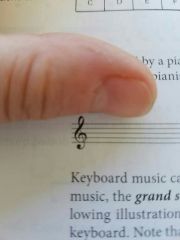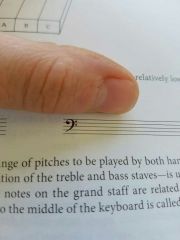![]()
![]()
![]()
Use LEFT and RIGHT arrow keys to navigate between flashcards;
Use UP and DOWN arrow keys to flip the card;
H to show hint;
A reads text to speech;
90 Cards in this Set
- Front
- Back
- 3rd side (hint)
|
Sound |
Vibrations that are transmitted usually through air to the eardrum which sends impulses to the brain |
|
|
|
Accelerando |
Becoming faster |
|
|
|
A cappella |
Choral music without instrumental accompaniment |
|
|
|
Accent |
Emphasis of a note, which may result from its being louder,longer,or higher in pitch than the notes near it |
|
|
|
Beat |
Regular,recurrent pulsation that divides music into equal units of time |
|
|
|
Bass |
Male voice of low range |
|
|
|
Climax |
Highest tone or emotional focal point in a melody or a larger musical composition |
|
|
|
Complete cadence |
Definite reading place, giving a sense of finality, at the end of a phase in a melody |
|
|
|
Consonance |
Tone combination that is stable and restful |
|
|
|
Contrast |
Striking differences of pitch, dynamics,rhythm,and tempo that provide variety and change of mood |
|
|
|
Chords |
combination of three or more tones sounded at once |
|
|
|
Church mode |
Like major or minor scales, seven different tones and an eighth tone that duplicates the first an octave higher, their patterns of whole and half steps are different |
|
|
|
Crescendo |
Gradually louder |
|
|
|
Chromatic scale |
Scale including all twelve tones of the octave , each tone is a half step away from the next one |
|
|
|
Counterpoint |
Technique of combining two or more melodic lines into a meaningful whole |
|
|
|
Interval |
The distance in pitch between any two tones |
|
|
|
Octave |
When tones are separated by the interval , they sound very much alike |
|
|
|
Pitch range or range |
The distance between the lowest and highest tones that voice or instruments can produce |
|
|
|
Dynamic |
Degrees of loudness and softness in music |
|
|
|
Tone color or timbre |
Is described by words such as bright,dark,brilliant,mellow,and rich |
|
|
|
Improvisation |
The term used for music created at the same time it's played |
|
|
|
Register |
Part of the total range of an instrument or voice. The tone color of the instrument or voice may vary with the ..... in which the is played or sung |
|
|
|
Double stop |
Two notes at once |
|
|
|
Vibrato |
The string player can produce a throbbing, expressive tone by rocking the left hand while pressing the string down. |
|
|
|
Mute |
The musician can veil or muffle the tone by fitting a clamp (mute) onto the bridge |
|
|
|
Tremolo |
The musician rapidly repeats tones by quick up and down strokes of the bow |
|
|
|
Harmonics |
Very high pitched tones, like a whistles, are produced when the musician lightly touches certain points on the string |
|
|
|
Pizzicato |
Plucked string |
|
|
|
Arco |
Playing with a bow like a violin |
|
|
|
Theme |
Ian a melody used for the basis for a musical composition |
|
|
|
Variations |
Varied repetitions of the theme |
|
|
|
Rhythm |
Is the flow of music through time |
|
|
|
Meter |
Organization of beats into regular groups |
|
|
|
Measure |
A group containing a fixed number of beats |
|
|
|
Duple meter |
When a measure has 2 beats in a measure |
|
|
|
Downbeat |
The first, or stressed, beat of the measure |
|
|
|
Syncopation |
When an accented note comes where we normally would not expect one |
|
|
|
Tempo |
The speed of the beat. The basic pace of the music |
|
|
|
Tempo indication |
Usually given at the beginning of apiece |
|
|
|
Ritardando |
Becoming slower |
|
|
|
Metronome |
An apparatus that produces ticking sounds or flashes of light at any desired musical speed |
|
|
|
Note |
Is an oval |
|
|
|
Staff |
A set of five horizontal lines |
|
|
|
Ledger lines |
If a pitch falls above or below the range indicated by the staff,short,horizontal |
|
|
|
Sharp sign |
# |
|
|
|
Flat sign |
b |
|
|
|
Clef |
Placed at the beginning of a staff to show the pitch of each line and space |
|
|
|
Treble clef |
Used for relatively high ranges |

|
|
|
Bass clef |
Used relatively low ranges |

|
|
|
Grand staff |
A combination of the treble and bass staves |
|
|
|
Time signature |
Shows the meter of a piece |
|
|
|
Score |
Shows the music for each instrumental or vocal category in a performance group |
|
|
|
Melody |
Is a series of single tones that add up to a recognizable whole |
|
|
|
Steps |
A melody moves by small intervals |
|
|
|
Leaps |
Melody moves by larger intervals |
|
|
|
Legato |
Are sung or played in a smooth, connected style |
|
|
|
Staccato |
May be performed in a short, detached manner |
|
|
|
Phrases |
Many melodies are made up of shorter parts |
|
|
|
Sequence |
A repetition of a melodic pattern at a higher or lower pitch |
|
|
|
Word painting |
The musical representation of specific poetic images |
|
|
|
Strophic form |
Repeating the same music for each stanza of a poem |
|
|
|
Through composed form |
Writing new music for each stanza |
|
|
|
Harmony |
The way chords are constructed and how they followed each other |
|
|
|
Progression |
As a melody unfolds,it provides clues for harmonizing ,but it does not always dictate a specific series, or... |
|
|
|
Dissonance |
A tone combination that is unstable |
|
|
|
Resolution |
A dissonance has it when it moves to a consonance |
|
|
|
Triad |
The simplest and most basic chord |
|
|
|
Tonic chord |
A Triad built on the first, or tonic, note of a scale |
|
|
|
Dominant chord |
The Triad built on the fifth note of the scale is next importance to tonic |
|
|
|
Cadence |
A progression from dominant chord to tonic chord, meaning both the resting point at the end of a melodic phrase and a chord progression that gives a sense of conclusion |
|
|
|
Broken chord or arpeggio |
When the individual tones of a chord are sounded one after the another |
|
|
|
Keynote or tonic |
The central tone, |
|
|
|
Key |
Involves not only a central tone but also a central scale and chord |
|
|
|
Scale |
Is made up of the basic pitches of a piece of music arranged in order from low to high or high to low |
|
|
|
Tonality |
Another term for key |
|
|
|
Major scale |
Do re mi fa sol la ti do, has two kinds of intervals in a specific pattern half step and whole step |
|
|
|
Half step |
Is the smallest interval traditionally used in western music |
|
|
|
Whole step |
Is twice as large as a half step |
|
|
|
Key signature |
Need context to determine the key pieces |
|
|
|
Modulation |
Shifting from one key to another within the same piece |
|
|
|
Tonic or home key |
No matter how often a piece changes key there's usually one main key |
|
|
|
Musical texture |
Refers to how many different layers of sound are heard at once or what kind of layers they are and how they are related to each other |
|
|
|
Monophonic |
Having one sound |
|
|
|
Unison |
Performance of a single melodic line at the same pitch by more than one instrument or voice is playing or singing results in a fuller richer surrounding one monophonic texture |
|
|
|
Polyphonic |
Having many sounds |
|
|
|
Imitation |
Occurs when a Melody idea as presented by one voice or instrument and is then restated immediately by another |
|
|
|
Homophobic |
When we hear one main melody accompanied by chords |
|
|
|
Repetition |
Creates a sense of unity |
|
|
|
Three part form |
Aba can be represented as statement (A) contrast or departure (B) return(A) |
|
|
|
Style |
Refers to a characteristic way of using Melody Rhythm tone color Dynamics Harmony texture and form |
|

